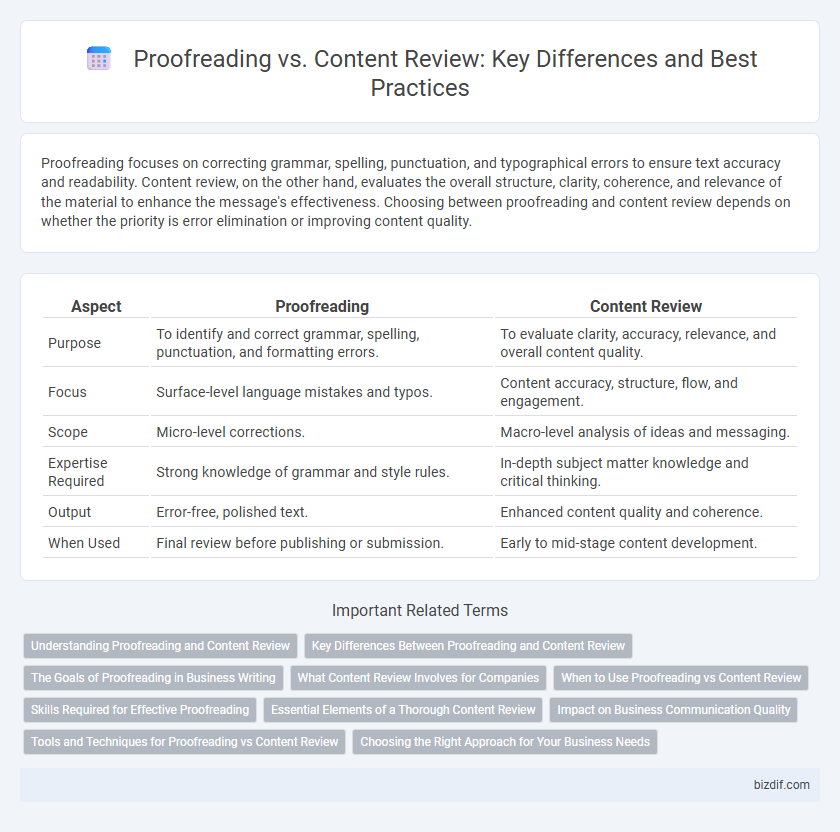Proofreading focuses on correcting grammar, spelling, punctuation, and typographical errors to ensure text accuracy and readability. Content review, on the other hand, evaluates the overall structure, clarity, coherence, and relevance of the material to enhance the message's effectiveness. Choosing between proofreading and content review depends on whether the priority is error elimination or improving content quality.
Table of Comparison
| Aspect | Proofreading | Content Review |
|---|---|---|
| Purpose | To identify and correct grammar, spelling, punctuation, and formatting errors. | To evaluate clarity, accuracy, relevance, and overall content quality. |
| Focus | Surface-level language mistakes and typos. | Content accuracy, structure, flow, and engagement. |
| Scope | Micro-level corrections. | Macro-level analysis of ideas and messaging. |
| Expertise Required | Strong knowledge of grammar and style rules. | In-depth subject matter knowledge and critical thinking. |
| Output | Error-free, polished text. | Enhanced content quality and coherence. |
| When Used | Final review before publishing or submission. | Early to mid-stage content development. |
Understanding Proofreading and Content Review
Proofreading involves meticulously checking a text for spelling, grammar, punctuation, and typographical errors to ensure linguistic accuracy and clarity. Content review focuses on evaluating the overall message, structure, coherence, and factual accuracy to enhance the effectiveness and relevance of the information. Understanding both processes helps improve written materials by addressing different aspects of quality control.
Key Differences Between Proofreading and Content Review
Proofreading focuses on correcting grammatical, spelling, punctuation, and formatting errors to ensure text accuracy and consistency. Content review emphasizes evaluating the overall structure, coherence, and clarity of ideas, often addressing factual accuracy and relevance. Key differences lie in proofreading's detail-oriented error correction versus content review's broader assessment of message effectiveness and logical flow.
The Goals of Proofreading in Business Writing
The goals of proofreading in business writing center on ensuring clarity, accuracy, and professionalism by eliminating spelling, grammar, and punctuation errors. It enhances the credibility of business documents, preventing miscommunication and preserving the company's reputation. Proofreading differs from content review by focusing on surface-level corrections rather than evaluating the overall message or structure.
What Content Review Involves for Companies
Content review for companies involves evaluating text for clarity, accuracy, and alignment with brand messaging to ensure effective communication. It includes assessing the overall organization, tone, and adherence to style guidelines, enhancing the content's appeal and engagement potential. This process often requires collaboration between writers, editors, and subject matter experts to optimize content quality and relevance.
When to Use Proofreading vs Content Review
Proofreading is essential for finalizing documents by correcting grammar, spelling, and punctuation errors, ensuring polished and error-free text. Content review should be used earlier in the writing process to evaluate clarity, structure, and coherence, improving overall message effectiveness. Use proofreading after content review to finalize and perfect the document before publication or submission.
Skills Required for Effective Proofreading
Effective proofreading demands meticulous attention to detail, strong command of grammar and punctuation rules, and the ability to identify inconsistencies in spelling, formatting, and syntax. Skills such as critical reading, familiarity with style guides, and a methodical approach to cross-checking facts are essential for ensuring text accuracy and integrity. These competencies differentiate proofreading from broader content review, which emphasizes content quality, coherence, and overall message clarity.
Essential Elements of a Thorough Content Review
A thorough content review requires evaluating structure, clarity, accuracy, and consistency to ensure the message is effectively communicated and free of errors. Unlike basic proofreading that focuses primarily on spelling, grammar, and punctuation, content review emphasizes fact-checking, logical flow, and alignment with the intended audience and purpose. Essential elements include assessing tone, source credibility, and formatting to enhance overall readability and engagement.
Impact on Business Communication Quality
Proofreading ensures error-free text, detecting spelling, grammar, and punctuation mistakes that uphold professionalism in business communication. Content review evaluates the clarity, relevance, and coherence of information, enhancing message effectiveness and audience engagement. Both processes combined significantly improve overall communication quality, leading to stronger brand reputation and clearer stakeholder interactions.
Tools and Techniques for Proofreading vs Content Review
Proofreading tools primarily focus on detecting grammatical errors, spelling mistakes, and punctuation accuracy, using software like Grammarly and Hemingway Editor to enhance textual precision. Content review techniques emphasize evaluating the overall clarity, coherence, and relevance of the content, often involving collaborative platforms such as Google Docs and editorial checklists to ensure message effectiveness. Combining automated proofreading tools with manual content review processes results in a polished and well-structured final draft.
Choosing the Right Approach for Your Business Needs
Proofreading ensures text accuracy by detecting spelling, grammar, and punctuation errors, while content review assesses overall message clarity, coherence, and alignment with brand voice. Selecting between proofreading and content review depends on business priorities--proofreading suits final-stage error correction, whereas content review supports refining ideas and enhancing audience engagement. Businesses aiming for polished, error-free communication must evaluate project goals and resources to choose the optimal approach for effective content quality control.
Proofreading vs Content Review Infographic

 bizdif.com
bizdif.com